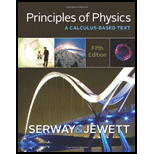
Bundle: Principles of Physics: A Calculus-Based Text, 5th + WebAssign Printed Access Card for Serway/Jewett's Principles of Physics: A Calculus-Based Text, 5th Edition, Multi-Term
5th Edition
ISBN: 9781133422013
Author: Raymond A. Serway; John W. Jewett
Publisher: Cengage Learning
expand_more
expand_more
format_list_bulleted
Question
Chapter 24, Problem 47P
To determine
The fraction of incident light transmitted.
Expert Solution & Answer
Want to see the full answer?
Check out a sample textbook solution
Students have asked these similar questions
3
Set
ба
||Axl
49.32
6b
71
Ay
22
Magnitude of A
Angle of A
24.04
Angle of -A
22
54
155.96
° (pos Ax) 204.04
° (neg Ax) 335.96
°
(pos Ax)
° (neg Ax)
115.77
° (pos Ax) 295.77
° (pos Ax)
-39
81
208.78
° (neg Ax) 28.78
°
(neg Ax)
3AA . not sure what i am getting wrong
Chapter 24 Solutions
Bundle: Principles of Physics: A Calculus-Based Text, 5th + WebAssign Printed Access Card for Serway/Jewett's Principles of Physics: A Calculus-Based Text, 5th Edition, Multi-Term
Ch. 24.1 - Prob. 24.1QQCh. 24.4 - Prob. 24.2QQCh. 24.4 - Prob. 24.3QQCh. 24.4 - Prob. 24.4QQCh. 24.6 - Prob. 24.5QQCh. 24.6 - Prob. 24.6QQCh. 24.7 - Prob. 24.7QQCh. 24 - Prob. 1OQCh. 24 - Prob. 2OQCh. 24 - Prob. 3OQ
Ch. 24 - If plane polarized light is sent through two...Ch. 24 - Prob. 5OQCh. 24 - Prob. 6OQCh. 24 - Prob. 7OQCh. 24 - Prob. 9OQCh. 24 - Prob. 10OQCh. 24 - Prob. 11OQCh. 24 - Consider an electromagnetic wave traveling in the...Ch. 24 - Prob. 1CQCh. 24 - Prob. 2CQCh. 24 - Prob. 3CQCh. 24 - Prob. 4CQCh. 24 - Prob. 5CQCh. 24 - Prob. 6CQCh. 24 - Prob. 7CQCh. 24 - Prob. 8CQCh. 24 - Prob. 9CQCh. 24 - Prob. 10CQCh. 24 - Prob. 11CQCh. 24 - Prob. 12CQCh. 24 - Prob. 1PCh. 24 - Prob. 2PCh. 24 - Prob. 3PCh. 24 - A 1.05-H inductor is connected in series with a...Ch. 24 - Prob. 5PCh. 24 - Prob. 6PCh. 24 - Prob. 7PCh. 24 - An electron moves through a uniform electric field...Ch. 24 - Prob. 9PCh. 24 - Prob. 10PCh. 24 - Prob. 11PCh. 24 - Prob. 12PCh. 24 - Figure P24.13 shows a plane electromagnetic...Ch. 24 - Prob. 14PCh. 24 - Review. A microwave oven is powered by a...Ch. 24 - Prob. 16PCh. 24 - A physicist drives through a stop light. When he...Ch. 24 - Prob. 18PCh. 24 - Prob. 19PCh. 24 - A light source recedes from an observer with a...Ch. 24 - Prob. 21PCh. 24 - Prob. 22PCh. 24 - Prob. 23PCh. 24 - Prob. 24PCh. 24 - Prob. 25PCh. 24 - Prob. 26PCh. 24 - Prob. 27PCh. 24 - Prob. 28PCh. 24 - Prob. 29PCh. 24 - Prob. 30PCh. 24 - Prob. 31PCh. 24 - Prob. 32PCh. 24 - Prob. 33PCh. 24 - Prob. 34PCh. 24 - Prob. 35PCh. 24 - Prob. 36PCh. 24 - Prob. 37PCh. 24 - Prob. 38PCh. 24 - Prob. 39PCh. 24 - Prob. 40PCh. 24 - Prob. 41PCh. 24 - Prob. 42PCh. 24 - Prob. 43PCh. 24 - Prob. 44PCh. 24 - Prob. 45PCh. 24 - Prob. 46PCh. 24 - Prob. 47PCh. 24 - Prob. 48PCh. 24 - You use a sequence of ideal polarizing filters,...Ch. 24 - Prob. 50PCh. 24 - Prob. 51PCh. 24 - Figure P24.52 shows portions of the energy-level...Ch. 24 - Prob. 53PCh. 24 - Prob. 54PCh. 24 - Prob. 55PCh. 24 - Prob. 56PCh. 24 - Prob. 57PCh. 24 - Prob. 58PCh. 24 - Prob. 59PCh. 24 - Prob. 60PCh. 24 - Prob. 61PCh. 24 - Prob. 62PCh. 24 - A dish antenna having a diameter of 20.0 m...Ch. 24 - Prob. 65PCh. 24 - Prob. 66PCh. 24 - Prob. 67PCh. 24 - Prob. 68PCh. 24 - Prob. 69PCh. 24 - Prob. 70PCh. 24 - Prob. 71PCh. 24 - A microwave source produces pulses of 20.0-GHz...Ch. 24 - A linearly polarized microwave of wavelength 1.50...Ch. 24 - Prob. 74PCh. 24 - Prob. 75P
Knowledge Booster
Learn more about
Need a deep-dive on the concept behind this application? Look no further. Learn more about this topic, physics and related others by exploring similar questions and additional content below.Similar questions
arrow_back_ios
SEE MORE QUESTIONS
arrow_forward_ios
Recommended textbooks for you
 University Physics Volume 3PhysicsISBN:9781938168185Author:William Moebs, Jeff SannyPublisher:OpenStax
University Physics Volume 3PhysicsISBN:9781938168185Author:William Moebs, Jeff SannyPublisher:OpenStax Principles of Physics: A Calculus-Based TextPhysicsISBN:9781133104261Author:Raymond A. Serway, John W. JewettPublisher:Cengage Learning
Principles of Physics: A Calculus-Based TextPhysicsISBN:9781133104261Author:Raymond A. Serway, John W. JewettPublisher:Cengage Learning Physics for Scientists and Engineers with Modern ...PhysicsISBN:9781337553292Author:Raymond A. Serway, John W. JewettPublisher:Cengage Learning
Physics for Scientists and Engineers with Modern ...PhysicsISBN:9781337553292Author:Raymond A. Serway, John W. JewettPublisher:Cengage Learning Physics for Scientists and EngineersPhysicsISBN:9781337553278Author:Raymond A. Serway, John W. JewettPublisher:Cengage Learning
Physics for Scientists and EngineersPhysicsISBN:9781337553278Author:Raymond A. Serway, John W. JewettPublisher:Cengage Learning Physics for Scientists and Engineers: Foundations...PhysicsISBN:9781133939146Author:Katz, Debora M.Publisher:Cengage Learning
Physics for Scientists and Engineers: Foundations...PhysicsISBN:9781133939146Author:Katz, Debora M.Publisher:Cengage Learning

University Physics Volume 3
Physics
ISBN:9781938168185
Author:William Moebs, Jeff Sanny
Publisher:OpenStax

Principles of Physics: A Calculus-Based Text
Physics
ISBN:9781133104261
Author:Raymond A. Serway, John W. Jewett
Publisher:Cengage Learning

Physics for Scientists and Engineers with Modern ...
Physics
ISBN:9781337553292
Author:Raymond A. Serway, John W. Jewett
Publisher:Cengage Learning

Physics for Scientists and Engineers
Physics
ISBN:9781337553278
Author:Raymond A. Serway, John W. Jewett
Publisher:Cengage Learning

Physics for Scientists and Engineers: Foundations...
Physics
ISBN:9781133939146
Author:Katz, Debora M.
Publisher:Cengage Learning

Polarization of Light: circularly polarized, linearly polarized, unpolarized light.; Author: Physics Videos by Eugene Khutoryansky;https://www.youtube.com/watch?v=8YkfEft4p-w;License: Standard YouTube License, CC-BY